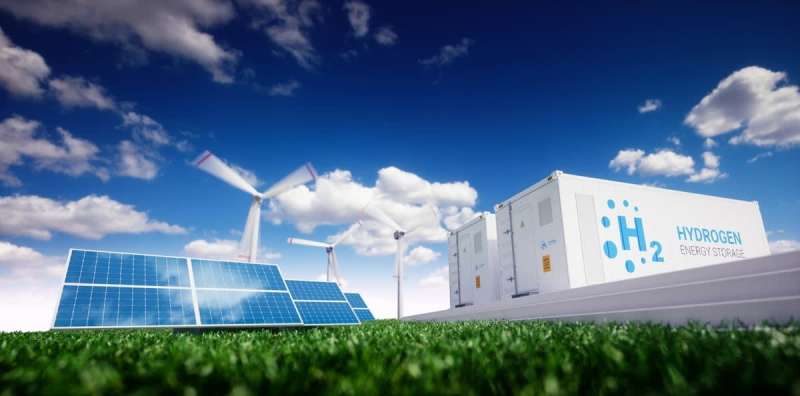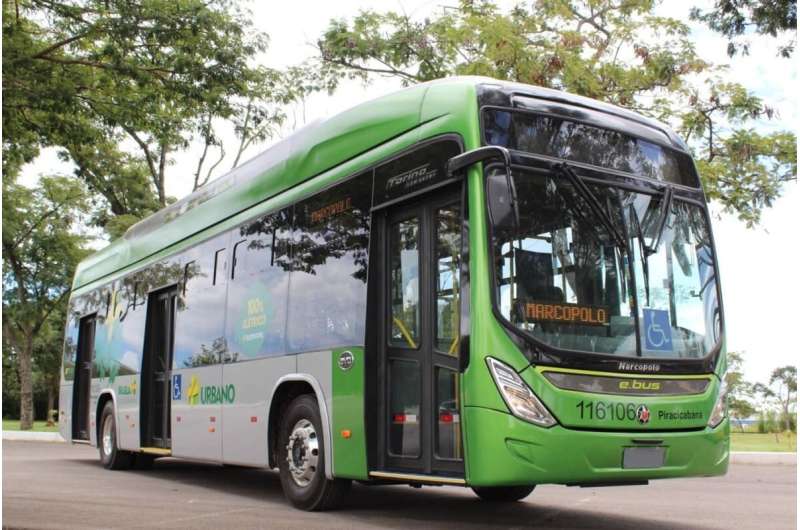Electrolysis breakthrough could solve the hydrogen conundrum

Hydrogen gas is the perfect green fuel—it can be extracted from water and is non-polluting. But although hydrogen is the most abundant element in the universe, it doesn't naturally occur in large quantities as a gas on Earth.
Hydrogen gas is the perfect green fuel—it can be extracted from water and is non-polluting. But although hydrogen is the most abundant element in the universe, it doesn't naturally occur in large quantities as a gas on Earth.
The race is on to find cheap, efficient, non-polluting ways of generating and storing hydrogen. It's long been known that an electric current will cause the elements of water—hydrogen and oxygen—to split to produce hydrogen and oxygen gases in a process known as electrolysis. This process can also be reversed to generate electricity when hydrogen and oxygen gases interact in a fuel cell (NASA has used fuel cells to power satellites and space capsules since the 1960s).
Until recently, the cost of electricity has been a roadblock to producing industrial quantities of hydrogen gas through electrolysis. But low-cost renewable electricity technologies have removed this barrier.
Another obstacle is that efficiently splitting water into hydrogen and oxygen gases has required rare and expensive metal catalysts such as platinum and iridium. Iridium is one of the rarest and most costly elements on Earth—it's often carried here by meteorites. And even the most stable iridium-based catalysts can only withstand electrolysis for a short time.
"If you increase the temperature while running water electrolysis, the iridium-based catalyst will dissolve and you lose it," explains Dr. Alexandr Simonov from the Monash School of Chemistry. "This is the worst thing that can happen, to dissolve something that costs hundreds of dollars per gram. It can also go into other components of your electrolytic device, contaminating them and preventing them from proper operation."
The first water electrolyzers used alkaline water, and this remains the traditional approach, Dr. Simonov says. But more advanced and efficient technology uses an acidic environment, using solid-state electrolytes—unfortunately, the catalysts can't withstand this environment for long.
Dr. Simonov and members of his research team, including Dr. Manjunath Chatti and James Gardiner, have made a discovery with enormous potential to solve the instability problem, making hydrogen generation by water electrolysis more economically viable.
"We're replacing iridium with elements that are abundant, cheap, and operate in a more stable manner," Dr. Simonov says. "We've demonstrated their stability in very strongly acidic conditions and up to 80°C, which is an industrially relevant temperature. We achieved absolutely no degradation."

Dr. Simonov describes the system he's developing with his team as "self-healing." Because all metals—even iridium—dissolve during electrolysis, the researchers wondered if the dissolved material could be redeposited on the electrode during operation.
"It turned out that it can," he says. "We've produced a highly active electrode surface based on abundant metals that is sustaining industrially relevant rates of water splitting." The high temperature and the strongly acidic environment "makes our most recent work different from pretty much everyone in the scientific world, and brings us closer to industry application," he says.
The Australian Renewable Energy Agency (ARENA) is funding further research, with the goal of producing greater efficiencies and developing a scalable electrode fabrication process, suitable for industry. Dr. Simonov and his team are working to achieve this goal with Monash chemistry Professor Douglas MacFarlane and collaborators from Australian National University, Professor Antonio Tricoli and Professor Yun Liu.
Australia, with its abundant sun and wind, has the potential to become a renewable energy superpower. By using electrolysis, hydrogen gas could be created from excess electricity generated by large renewable electricity projects. This hydrogen could be used as a fuel within Australia and exported to countries hungry for fossil fuels alternatives.
Hydrogen-fueled buses are now on the road in Brazil, and South Korea and Japan have already demonstrated a strong commitment to adopting hydrogen-powered vehicles and hydrogen as their main energy carrier.
Federal Resources Minister Matt Canavan this week signed a letter of intent with South Korea to develop a hydrogen plan by the year's end, signaling the Australian government's intent to widen the export potential. The push coincides with the the release of a Geoscience Australia report naming the country as a future "world leader" in the field.
But hydrogen gas is highly combustible, and transporting it presents some challenges. One future possibility is to convert the gas to ammonia. This goal is also being explored by Dr. Simonov and colleagues within the Monash Ammonia Project led by Professor MacFarlane.
Dr. Simonov says that in the meantime, energy provider AGL is investigating how the electrolysis breakthrough can be scaled up to add sustainably produced hydrogen to natural gas lines in Australia, as a way of reducing carbon emissions. Hydrogen is already being used in this way in the northern hemisphere, Dr. Simonov says. Another leading Australian company demonstrating strong interest in hydrogen technologies is Woodside, which has made substantial investments in Monash research.
Dr. Simonov and Professor MacFarlane are also collaborating with an emerging Australian company, ANT Energy Solutions, which is developing a portable hydrogen electrolyzer with funding from the Cooperative Research Centres Program. A portable unit could be loaded onto a truck and transported to wherever cheap renewable energy is available, Dr. Simonov says.
Provided by Monash University



















